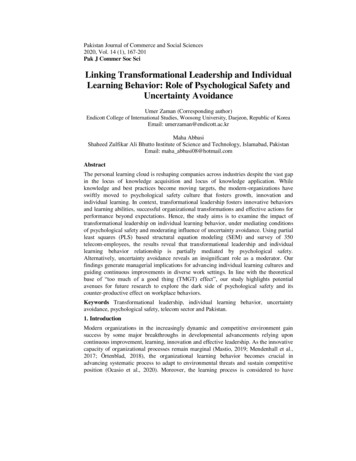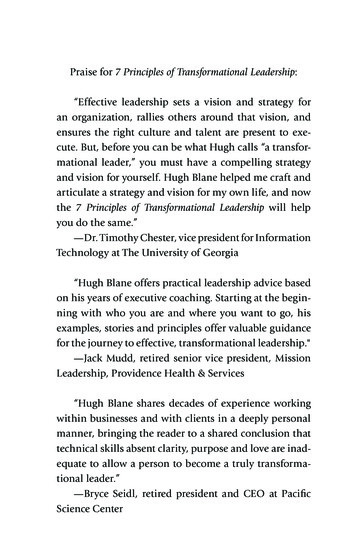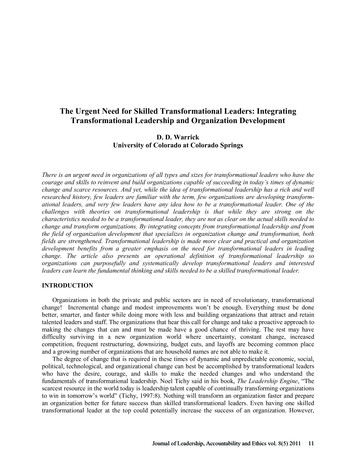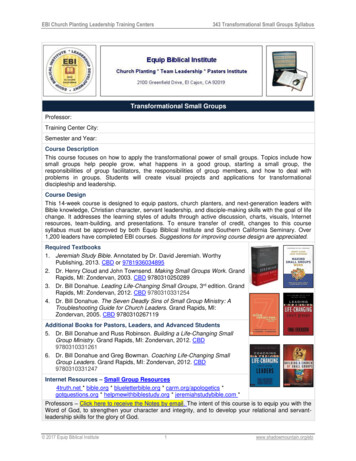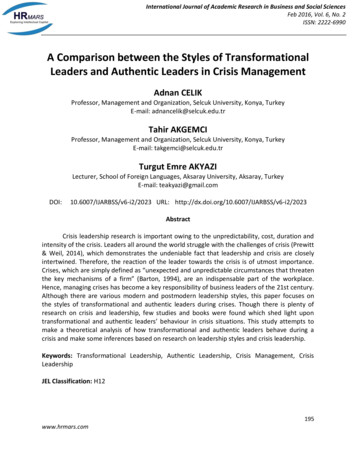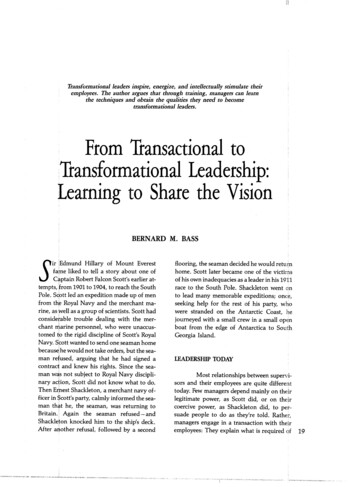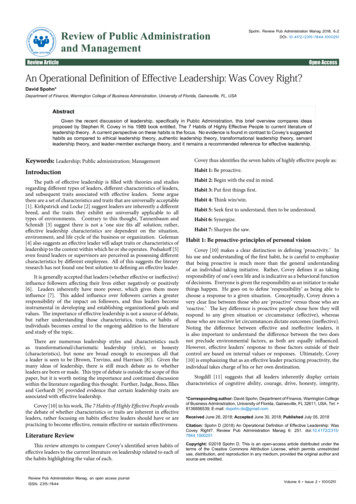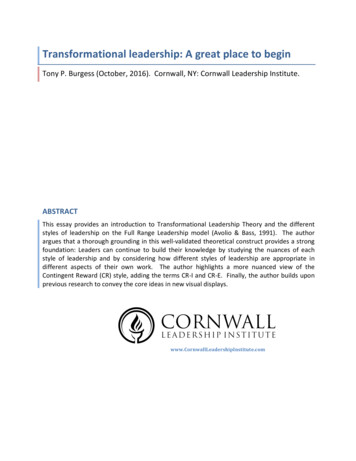
Transcription
Transformational leadership: A great place to beginTony P. Burgess (October, 2016). Cornwall, NY: Cornwall Leadership Institute.ABSTRACTThis essay provides an introduction to Transformational Leadership Theory and the differentstyles of leadership on the Full Range Leadership model (Avolio & Bass, 1991). The authorargues that a thorough grounding in this well-validated theoretical construct provides a strongfoundation: Leaders can continue to build their knowledge by studying the nuances of eachstyle of leadership and by considering how different styles of leadership are appropriate indifferent aspects of their own work. The author highlights a more nuanced view of theContingent Reward (CR) style, adding the terms CR-I and CR-E. Finally, the author builds uponprevious research to convey the core ideas in new visual displays.www.CornwallLeadershipInstitute.com
[Transformational leadership: A great place to begin] 1I am writing this essay for people who are taking steps to get serious about leadership. I have inmind both the new practitioner and the person who has been leading for years. I believe thatleaders are more effective to the degree to which they thoughtfully weave together practice andtheory—experience and new knowledge—over time in a spiral of continuous learning.IntroductionThe study of leadership has grown exponentially over the last several decades, so much so thatit can be challenging to discern where to begin. A search for books with “leadership” in the titleon Amazon.com serves up 189,863 choices.1 Amidst the plethora of perspectives on whatleadership is and what makes an effective leader, there are few leadership theories that havebeen validated, which is to say “proven to predict performance outcomes” (Avolio, 2011, p.203). Transformational Leadership Theory has been rigorously tested across a wide-range ofcontexts (military, corporate, nonprofit, global, etc.) and is well grounded in scientific evidence,perhaps more so than any other leadership theory (Bass, 1999; Lowe & Gardner, 2001). Severalmeta-analyses (analysis of all the studies to date on the topic) have found that transformationalleaders are more effective than non-transformational leaders (e.g., Judge & Piccolo, 2004;Lowe, Kroeck, & Sivasubramaniam, 1996). Bass’ conceptualization of the theory, first publishedin 1985, has remained consistent with the initial propositions, as it has evolved. And becausetransformational leadership is especially effective in times of crises, uncertainty, volatility, andturbulence, the theory may be more relevant now than it was 30 years ago (Bass, 1998, p. 28 &p. 53). The theoretical model, as we will see, is a balance between specific and general—and it1Search on Amazon.com October 13, 2016.
2[Transformational leadership: A great place to begin]serves well as a foundational theory upon which to build and integrate other leadershiptheories and principles. In short, Transformational Leadership Theory is a great place to begin.2Origins of the TheoryThe roots of Transformational Leadership Theory begin with James Downton (1973) who firstused the term “transformational leadership.” From there, the roots of the theory can be tracedthrough Robert House’s “1976 Theory of Charismatic Leadership” to James MacGregor Burns’Pulitzer Prize winning book Leadership. Burns (1978) contrasted transactional leadership withwhat he called “transforming” leadership and described it this way:The relations of most leaders and followers are transactional—leaders approachfollowers with an eye to exchanging one thing for another: jobs for votes, orsubsidies for campaign contributions. Such transactions comprise the bulk of therelationships among leaders and followers Transforming leadership, while morecomplex, is more potent. The transforming leader recognizes and exploits anexisting need or demand of a potential follower. But, beyond that, thetransforming leader looks for potential motives in followers, seeks to satisfyhigher needs, and engages the full person of the follower. The result oftransforming leadership is a relationship of mutual stimulation and elevationthat converts followers into leaders and may convert leaders into moral agents(p. 4).And:[Transforming leadership] occurs when one or more persons engage with othersin such a way that leaders and followers raise one another to higher levels ofmotivation and morality. Their purposes, which might have started out asseparate but related, as is the case of transactional leadership, become fused.Power bases are linked not as counterweights but as mutual support forcommon purpose [T]ransforming leadership ultimately becomes moral in that itraises the level of human conduct and ethical aspiration of both leader and led,and thus it has a transforming effect on both (p. 20).2Transformational Leadership Theory is not without critics. For example, see Yukl’s critique (1999) as well as VanKnippenberg & Sitkin (2013) who recommend we go back to “the drawing board.”
[Transformational leadership: A great place to begin] 3Burns was writing about political leadership, but his insights transcended that particular contextand caught the attention of a number of scholars who began exploring transformationalleadership. These include, for example, influential scholars like Warren Bennis, Burt Nanus,Noel Tichy, Jay Conger, Bruce Avolio, Boas Shamir, James Kouzes, and Barry Posner. Onescholar in particular, Bernard Bass (1925-2007), would spend the rest of his life conceptualizing,researching, and teaching what became known as Transformational Leadership Theory and theFull Range Leadership model.The Full Range Leadership ModelIn their conception of Transformational Leadership Theory, Avolio and Bass (1991) describe arange of styles of leadership from laissez faire to transactional to transformational.Figure 1: Full Range Leadership (Avolio & Bass, 1991) Laissez Faire leadership is essentially non-leadership; the leader avoids taking action. Transactional leadership “refers to the exchange relationship between leader andfollower to meet their own self-interests” (Bass, 1999, p. 10). It includes clarifyingexpectations and standards and then providing either rewards or corrective actionaccordingly. Transformational leadership “involves inspiring followers to commit to a sharedvision and goals for an organization or unit, challenging them to be innovativeproblem solvers, and developing followers’ leadership capacity via coaching,mentoring, and provision of both challenge and support” (Bass & Riggio, 2006, p.4).
4[Transformational leadership: A great place to begin]In general, transformational leadership is more effective than transactional leadership, whichis—in turn—more effective than laissez faire leadership (Bass & Bass, 2008, p. 624). However, akey, often overlooked point is that the most effective leaders use all of the styles to someextent, utilizing the style that’s most appropriate to the situation. Transformational leadershipis not always the “right” style for every context.In fact, as Avolio describes it, “leadership at the base of leadership effectiveness” istransactional (1999, p. 13). Transactional leadership provides the base upon which leaders canbuild higher-order styles. Transactional leadership centers on clarifying requirements andexpectations—either in a directive style, from the leader to the followers, or in a participativestyle involving the followers—and then either rewarding or correcting team membersaccordingly. People want to know the mission of the organization. They want to know what isexpected of them. Avolio’s research findings support this: “leaders who set clearly definedexpectations and agreed-on levels of performance” are more effective than those who do not(1999, p. 13). Avolio argues that the first building block of effective leadership is “first andforemost an articulation of the expectations you have of yourself and of others you areattempting to influence over time” (1999, p. 13).Clear expectations and consistentreinforcement of those expectations over time build trust and are essential.
[Transformational leadership: A great place to begin] 5Avolio and Bass break down transactional leadership into subcomponents: ManagementBy Exception (MBE), both passive and active—which is corrective—and Contingent Reward(CR)—which is constructive.Figure 2: Components of Transactional Leadership (Avolio & Bass, 1991)Management by Exception (MBE) is a corrective transaction, meaning the leader corrects—orholds to account—followers who do not meet agreed upon expectations. In the carrot andstick approach to motivation, MBE is the stick.“The corrective action may be negativefeedback, reproof, disapproval, or disciplinary action” (Bass & Bass, 2008, p. 624). MBE isfurther broken down to “active”—which means that the leader actively monitors followers andtakes corrective action as necessary—and “passive”—which means that the leader turnsattention to the follower only after a mistake or some deviation from standard has occurred. Incertain contexts such as high-risk or emergency situations when lives are on the line, MBE-Amay be an effective leadership style and will be interpreted in a positive light (Avolio, 1999, p.47; Bass, Avolio, Jung, & Berson, 2003). Although the preponderance of the research has foundMBE-P to be a less effective style (only surpassed in ineffectiveness by the Laissez Faire style),there are times when it is appropriate, or even required. For example, consider a leader with alarge number of followers—most who have proven to be competent and trustworthy—operating in a geographically distributed environment. The leader may actively monitor (MBEA) her less experienced followers while choosing to use a more passive monitoring approach(MBE-P) with the others.
6[Transformational leadership: A great place to begin]Contingent Reward (CR), on the other hand, is constructive—the carrot. “The leaderassigns or gets agreement on what needs to be done and promises rewards or actually rewardsothers in exchange for satisfactorily carrying out the assignment” (Bass, 1998, p. 6). AlthoughCR was initially considered purely transactional, subsequent research has taken a morenuanced view of CR (Avolio, Bass, and Jung, 1999; Antonakis, 2001; Goodwin, Wofford, andWhittington, 2001). For example, rewards can be categorized as psychological or material.Psychological rewards include “positive feedback, praise, and approval,” and material rewardsinclude “a raise in salary, an award, or citation for merit” (Bass and Bass, 2008, p. 623).Connecting this insight to the research of Deci on motivation (1995), we could say that rewardsthat activate extrinsic motivation (e.g., material rewards) tend to be transactional whilerewards that activate intrinsic motivation (e.g., psychological rewards) “may be a bridge totransformational leadership, especially where recognition is more individualized” (Bass, Jung,Avolio, Berson, 2003, p. 215). Psychological (intrinsic) rewards infer an emotional humanconnection between the follower and the leader and a growing identification between thefollower and the leader and/or the organization—which moves one into the transformationalstyle of leadership. I will refer to these as CR-I (Intrinsic) and CR-E (Extrinsic) to differentiate thetwo.In summary, there are a number of leadership styles on the full range.3 The mosteffective leaders use all the styles; even the lower-order styles are appropriate in certainsituations. Transactional leadership may be viewed as the base foundation of leadership3Bass and Avolio’s conceptualization of the full range leadership model was not intended to be all-inclusive; infact, as Avolio describes it, “we were intellectually stimulating the field to add more as the range would no doubtexpand over time” (Bruce Avolio, personal communication, October 8, 2016).
[Transformational leadership: A great place to begin] 7effectiveness; alone, however, its impact is short-term and fails to have a transformative impacton followers and organizations. “In all, transactional leadership is not enough for people toachieve their full potential, whether they are leaders or followers, individuals or in groups”(Avolio, 1999, p. 37). “[T]he best of leaders are both transformational and transactional butthey are likely to be more transformational and less transactional than poorer leaders” (Bass,1998, p.99).Transformational Leadership (The “4 I’s”)Transformational leadership, at its essence, is leadership that moves followers to go beyondsimply meeting expectations—to reach their full potential and to be extraordinary. To inspireand develop followers in this way, leaders must frequently exercise a transformational style ofleadership that builds upon—does not replace—transactional leadership and which consists offour components (the “4 I’s”): Idealized Influence, Inspirational Motivation, IntellectualStimulation, and Individualized Concern.Figure 3: The “4 I’s” (adapted from Avolio & Bass, 1991)
8[Transformational leadership: A great place to begin]Bass, Avolio, and colleagues have stated that transformational leaders “behave in ways toachieve superior results by employing one or more of the Four I’s” (Bass & Avolio, 1994, p. 3).Yet, to go beyond practicing a transformational style of leadership to being labeled atransformational leader, a person needs to employ all four I’s to a high degree (Bruce Avolio,personal communication, October 8, 2016). Bass, Avolio, Jung, and Berson (2003, p. 208)provide a succinct description of the four components of transformational leadership:Idealized Influence (II). These leaders are admired, respected, and trusted.Followers identify with and want to emulate their leaders. Among the things theleader does to earn credit with followers is to consider followers’ needs over hisor her own needs. The leader shares risks with followers and is consistent inconduct with underlying ethics, principles, and values.Inspirational Motivation (IM). Leaders behave in ways that motivate thosearound them by providing meaning and challenge to their followers’ work.Individual and team spirit is aroused. Enthusiasm and optimism are displayed.The leader encourages followers to envision attractive future states, which theycan ultimately envision for themselves.Intellectual Stimulation (IS). Leaders stimulate their followers’ effort to beinnovative and creative by questioning assumptions, reframing problems, andapproaching old situations in new ways. There is no ridicule or public criticism ofindividual members’ mistakes. New ideas and creative solutions to problems aresolicited from followers, who are included in the process of addressing problemsand finding solutions.Individualized Consideration (IC). Leaders pay attention to each individual’sneed for achievement and growth by acting as a coach or mentor. Followers aredeveloped to successively higher levels of potential. New learning opportunitiesare created along with a supportive climate in which to grow. Individualdifferences in terms of needs and desires are recognized.It is important to clarify that these components are not prescriptive behaviors. Rather, they arebetter understood as descriptions of a style of leadership that, over time, has transformingeffects.
[Transformational leadership: A great place to begin] 9Another way to envision the model is with performance thresholds: one threshold thatleaders must cross to achieve base performance expectations, and another that leaders mustcross to achieve extraordinary performance. Leaders build a foundation with transactionalleadership (MBE-P, MBE-A, CR-E), which moves their followers across the base performancethreshold. Leaders use CR-I and then the “4 I’s” to move their followers across theextraordinary performance threshold where transformation begins.Figure 4: Full Range Leadership Performance ThresholdsAs Bass and Riggio put it, “Transactional leadership, particularly contingent reward, provides abroad basis for effective leadership, but a greater amount of effort, effectiveness, andsatisfaction is possible from transactional leadership if augmented by transformationalleadership” (2006, p. 11).
10 [Transformational leadership: A great place to begin]What are the Positive Outcomes of Transformational Leadership?Based on the empirical research, leaders who practice one or more of the components oftransformational leadership over a period of time significantly increase the likelihood that theywill “motivate others to do more than they originally intended and often even more than theythought possible.They set more challenging expectations and typically achieve higherperformances” (Bass, 1998, p. 4). Moreover, followers of transformational leaders are moresatisfied than followers of transactional leaders (Bass & Riggio, 2006). Another key finding inthe research is that followers of transformational leaders exhibit higher levels of commitment–both to the work and to the organization (Bass, 1998; Avolio, 2011). These followers believe inwhat they are doing and this “identification,” as Avolio puts it, “provides the high-octane forachieving exemplary performance” (Avolio, 1999, p. 40). There are a number of additionalpositive findings in the research—for example, higher levels of creativity, innovation, and abilityto overcome adversity (Bass & Riggio, 2006)—but based on my assessment, the outcomes bestsupported by the research are higher levels of commitment, satisfaction, and performance.
[Transformational leadership: A great place to begin] 11Figure 5: Positive Impact of Transformational LeadershipThe “key to success,” as Bass and Riggio put it, is for leaders to “challenge followers toperform beyond normal expectations, to stimulate them to be creative and innovative, and todevelop their collective leadership capacity” (2006, p. 2). Notice the last part of the sentence.Another essential outcome of transformational leadership is that followers are developed; overtime, they become leaders. And leaders, according to Burns, are transformed into moral agents(Burns, 1978). When leaders cross the “extraordinary performance threshold” depicted inFigure 4 above, they begin to have a life changing—a transforming and morally uplifting—effecton their followers, on themselves, and on their organizations.
12 [Transformational leadership: A great place to begin]ConclusionThere are more books on leadership than most of us could read in a lifetime. Leadershiptheories abound. Where, then, should people who want to get serious about leadership begintheir study? In this essay, I have made the case for Transformational Leadership Theory as agreat place to start. A thorough grounding in this well-validated theoretical construct providesa strong foundation. Leaders can continue to build their knowledge by studying the nuances ofeach style of leadership and by considering how different styles of leadership are appropriate indifferent aspects of their own work.In describing how to train and educate leaders, Bass tells us that participants must gainan appreciation for the range of potential leadership behaviors used by effective leaders, butthat learning to lead must go beyond skill training. “It must be internalized ” (Bass, 1998, p.99). Transformational Leadership Theory is as much about who you are as a leader as it isabout what you do. And, as such, it is not a prescriptive list of leadership rules. Harkening backto the “be” component of the U.S. Army’s “Be, Know, Do” model (HQDA, 2006, p. 1-1), leaderswho “are” transformational are role models to their followers. They know how to utilize thefull range of leadership styles. They consistently do the right thing and put the needs of themission and their followers above their own needs. They act as catalysts for creating sharedvisions of a positive future. They bring to bear the full talent of their followers in makingprogress on difficult problems. They spur on their teams to be creative and innovative with afocus on achieving the best possible outcomes for the organization and their team members.They challenge and support each individual to reach their full potential and foster a culture thatfacilitates a relentless pursuit of excellence in a supportive and positive way.
[Transformational leadership: A great place to begin] 13ReferencesAntonakis, J. (2001). The validity of the transformational, transactional, and laissez-faireleadership model as measured by the Multifactor Leadership Questionnaire (MLQ 5X).Unpublished doctoral dissertation, Walden University, Minneapolis.Avolio, B.J. (1999). Full leadership development: Building the vital forces in organizations.Thousand Oaks, CA: Sage Publications.---. (2011). Full range leadership development (2d Edition). Thousand Oaks, CA: SagePublications.Avolio, B.J., & Bass, B.M. (1991). The full range of leadership development: Basic and advancedmanuals. Binghamton, NY: Bass, Avolio & Associates.Avolio, B. J., Bass, B. M., & Jung, D. (1999). Reexamining the components of transformationaland transactional leadership using the Multi-factor Leadership Questionnaire. Journal ofOccupational and Organizational Psychology, 7, 441–462.Bass, B.M. (1985). Leadership and performance beyond expectations. New York: Free Press.---. (1998). Transformational leadership: Industrial, military, and educational impact. Mahwah,NJ: Lawrence Erlbaum Associates.---. (1999). Two decades of research and development in transformational leadership. EuropeanJournal of Work and Organizational Psychology, 8, 9-32.Bass, B.M., & Avolio, B. J. (Eds.). (1994). Improving organizational effectiveness throughtransformational leadership. Thousand Oaks: Sage Publications.Bass, B.M., Avolio, B. J., Jung, D. I., & Berson, Y. (2003). Predicting unit performance byassessing transformational and transactional leadership. Journal of AppliedPsychology, 88(2), 207-218.Bass, B.M., & Bass, R. (2008). The Bass handbook of leadership: Theory, research, andmanagerial applications. New York: Free Press.Bass, B.M., & Riggio, R.E. (2006). Transformational Leadership (2d Edition). New York: Taylor &Francis Group, LLC.Burns, J.M. (1978). Leadership. New York: Harper & Row.Deci, E.L. & Flaste, R. (1995). Why we do what we do: Understanding self-motivation. New York:Penguin Books.
14 [Transformational leadership: A great place to begin]Downton, J.V. (1973). Rebel leadership: commitment and charisma in the revolutionary process.New York: Free Press.Headquarters, D.A. (2006). Field manual (FM) 6-22, army leadership. Washington D.C.:Department of the Army.House, R.J. (1976). A 1976 theory of charismatic leadership. University of Toronto: WorkingPaper.Goodwin, V.L., Wofford, J.C., & Whittington, J.L. (2001). A theoretical and empirical extensionto the transformational leadership construct. Journal of Organizational Behavior, Vol.22, 759-774.Judge, T. A., & Piccolo, R.F. (2004). Transformational and transactional leadership: A Metaanalytic test of their relative validity. Journal of Applied Psychology, Vol. 89, No. 5, 755–768.Lowe, K. B., & Gardner, W. L. (2001). Ten years of the leadership quarterly: Contributions andchallenges for the future. The Leadership Quarterly, 11(4), 648-657.Lowe, K.B., Kroeck, K.G., & Sivasubramaniam, N. (1996). Effectiveness correlates oftransformational and transactional leadership: A meta-analytic review of the MLQliterature. The Leadership Quarterly, 7(3), 385-425.Van Knippenberg, D. & Sitkin, S.B. (2013). A critical assessment of charismatic—transformational leadership research: Back to the drawing board? The Academy ofManagement Annals, Vol. 7, Iss. 1.Yukl, G. (1999). An evaluation of conceptual weaknesses in transformational and charismaticleadership theories. The Leadership Quarterly, 10(2), 285-305.
Oct 13, 2016 · 4 [Transformational leadership: A great place to begin] In general, transformational leadership is more effective than transactional leadership, which is—in turn—more effective than laissez faire leadership (Bass & Bass, 2008, p. 624). However, a key, often overlooked point is that
